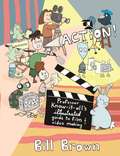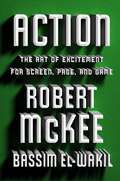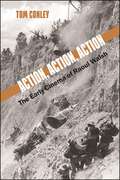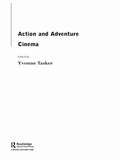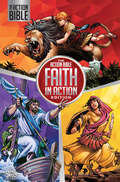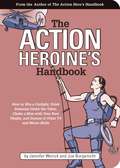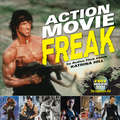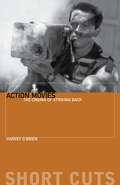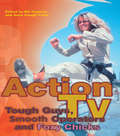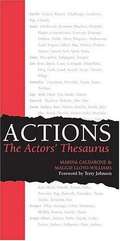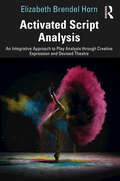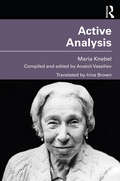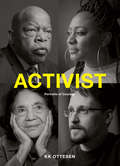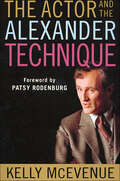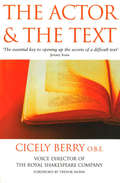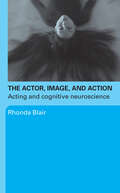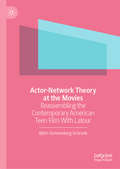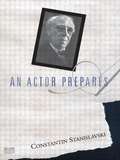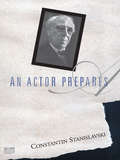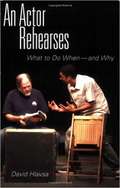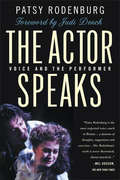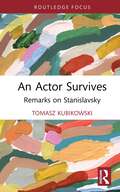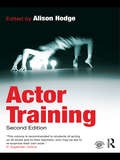- Table View
- List View
Action!: Professor Know-it-all's Guide To Film And Video (Diy Ser.)
by Bill BrownHave you ever wanted to make your own movies? In this easy-to-read and lavishly illustrated volume, you will learn why movies move; how film and video cameras work; how to light and expose your shots to get the best results; how to create eye-pleasing compositions; and how to record crystal clear sounds. It's a do-it-yourself guidebook for film and video makers of all ages and experience levels.
Action: The Art of Excitement for Screen, Page, and Game
by Robert McKee Bassim El-WakilFrom the master of Story, Dialogue, and Character, ACTION offers writers the keys to propulsive storytelling. ACTION explores the ways that a modern-day writer can successfully tell an action story that not only stands apart, but wins the war on clichés. Teaming up with the former co-host of The Story Toolkit, Bassim El-Wakil, legendary story lecturer Robert McKee guides writers to award-winning originality by deconstructing the action genre, illuminating the challenges, and, more importantly, demonstrating how to master the demands of plot with surprising beats of innovation and ingenuity.Topics include: Understanding the Four Core Elements of ActionCreating the Action CastHook, Hold, Pay Off: Design in ActionThe Action MacguffinAction Set PiecesThe Sixteen Action SubgenresA must-add to the McKee storytelling library, ACTION illustrates the principles of narrative drive with precision and clarity by referencing the most popular action movies of our time including: Die Hard, The Star Wars Saga, Dark Knight, The Matrix, and Avengers: Endgame.
Action, Action, Action: The Early Cinema of Raoul Walsh (SUNY series, Horizons of Cinema)
by Tom ConleyDirector of over 150 films from 1912 to 1964, Raoul Walsh was a core figure in Hollywood from its beginnings to the end of the studio system. Perhaps best known for such films as The Big Trail (starring John Wayne in his first leading role), High Sierra, and White Heat, Walsh cut his teeth under D. W. Griffith, and, like his contemporary John Ford, found a style and signature in his silent cinema and early talkies. Through close analysis of seven of his films, six shot between 1915 and 1933 and one a remake from 1956, and stressing the visual character of their settings and situations, Tom Conley examines how composition and montage—or action—often overtake the crisp narratives these films convey. Rife with contradiction, they ask us to see what makes them possible and how they contend with prevailing codes. Films discussed include Regeneration (1915); Sadie Thompson (1928) and a likely avatar, The Revolt of Mamie Stover (1956); The Cock-Eyed World (1929); The Big Trail (1930); Me and My Gal (1932); and The Bowery (1933).
The Action and Adventure Cinema
by Yvonne TaskerThis exciting collection addresses action and adventure from the silent to the contemporary period exploring diverse questions of aesthetics, industry and ideology. Action has established itself as one of the leading commercial genres of the New Hollywood cinema, generating extensive debate in the process.Contributors consider how action might best be defined, how it has developed historically, and how it works formally. The critical reception and standing of action and adventure cinema is considered in relation to questions of national culture, violence and the 'art' of cinema.Themes explored include genre and definitions; early action, sensation and melodrama; authorship and action; national and transnational action-adventure traditions; action aesthetics; spectacle and narrative; stars and bodies; class; gender; race and ethnicity. Attempting to evaluate the significance of this type of filmmaking for both popular cinema and film studies, the book underlines the central place of action and adventure within film history.
The Action Bible: Faith in Action Edition
by Sergio CarielloThis reimagining of the mega-selling Action Bible combines 230 stories of biblical heroes with vibrant comic-book-style illustrations and an immersive online experience. Readers will explore seven dynamic attributes of God&’s story, earn Faith in Action Badges representing those qualities, and discover even more through a discoverable QR code in each story that takes them to a safe online adventure of games, playlists, Bible studies, activities, and a complete devotional designed to increase their time with God. Since its release in 2010, The Action Bible has received widespread acclaim for its high-energy, engaging graphics and over 230 spiritually-transformative Bible stories. Introducing the Faith in Action program that reinvents the bestselling, comic-book-style Bible with a systematic approach to experiencing the Word of God for the next generation. In addition to an interior redesign refresh, this exciting edition includes: The Faith in Action system which gives young readers an easy-to-navigate and engaging experience for exploring the Bible through themes that connect directly to their felt needs. A Faith in Action Badge for each story that corresponds with one of seven biblical attributes: courage, faith, hope, love, service, trust, and wisdom. Discoverable QR codes in every story take readers to a safe online experience to explore even more content: videos, games, a digital Scripture index, prayers, Bible facts, devotions, playlists, reading plans, interactive maps, Bible study sessions, and more. A reading challenge chart spurs young readers on to earn a Faith in Action Title. With all the intrigue of a graphic novel and all the truth of God&’s Word, The Action Bible: Faith in Action Edition satisfies the curious minds and adventurous hearts of today&’s young learners, guiding them to connect more deeply with God&’s Word, develop a richer relationship with their Savior, and grow in their compassion for the world around them.
The Action Heroine's Handbook: How to Win a Catfight, Drink Someone Under the Table, Choke a Man with Your Bare Thighs, and Dozens of Other TV and Movie Skills
by Joe Borgenicht Jennifer WorickGet Some Action! For every woman who wants to be as tough as Lara Croft, as nimble as the Bionic Woman, and as babe-a-licious as Charlie's Angels, The Action Heroine's Handbook shows you the essential skills you'll need to conquer the bad guys and save the day without breaking a sweat. Find out how the real action heroines do it, directly from a host of experts, including stuntwomen, jujitsu instructors, helicopter pilots, detectives, forensic psychologists, survivalists, primatologists, and many others. Learn to: * Profile a serial killer * Outwit a band of home intruders * Navigate white water rapids * Go undercover as a beauty queen * Outrun a fireball, and dozens of other Tough Chick Skills, Beauty Skills, Brain Skills, Brawn Skills, and Escape Skills. Special sections and appendices feature the top action heroine hairdos, handbag essentials, and the best footwear for every action situation. With step-by-step instructions and easy-to-follow illustrations, The Action Heroine's Handbook will prepare you to save the world, one baddie at a time.
Action Movie Freak
by Katrina HillWritten by woman of action Katrina "Action Flick Chick" Hill, Action Movie Freak is packed with spine-tingling excitement and thrilling moments that make action movies a beloved genre for those who crave crashing cars, exploding buildings, and faces getting kicked six ways to Sunday. With badass heroes that ain't got time to bleed, women warriors, thrilling chases and outrageous fisticuffs, Action Movie Freak celebrates a wide variety of more than 100 movies that have left audiences on the edge of their seats. Complete movie reviews are divided into various sub-genres including Classics That Defined the Genre (The Bond movies of the 1960s, "Bullit," "Dirty Harry") Bloodiest Action Movies ("Ninja Assassin," "Rambo" series, "RoboCop") and Action From the Far East ("Bangkok Knockout," "Ong Bak," "Ip Man"). The book also spotlights specific action heroes/actors, and features 250 color photos and movie posters, as well as fun Top 10 lists, including best one-liners and most over-the-top kills.
Action Movies: The Cinema of Striking Back
by Harvey O'BrienAction Movies: The Cinema of Striking Back is a study of action cinema, exploring the ethics and aesthetics of the genre with reference to its relatively short history. It moves from seminal classics like Bullitt (1968) and Dirty Harry (1971) through epoch-defining films like Rambo: First Blood Part II (1985) and Die Hard (1988) to revisions, reboots, and renewals in films like Kill Bill Vol. 1 (2003), Taken (2008), and The Expendables (2010). The action genre is a fusion of form and content: a cinema of action about action. It is a cinema of the will, configured as a decisive reaction to untenable circumstances. Action heroes take up arms against the sea of troubles that beset them, safe in the knowledge that if they don't do it, nobody will. Though this makes the action movie profoundly disturbing as an embodiment of moral ideology, its enduring appeal proves the appetite for assurance remains undiminished, even in the wake of 9/11.
Action Movies: The Cinema of Striking Back
by Harvey O'BrienAction Movies: The Cinema of Striking Back is a study of action cinema, exploring the ethics and aesthetics of the genre with reference to its relatively short history. It moves from seminal classics like Bullitt (1968) and Dirty Harry (1971) through epoch-defining films like Rambo: First Blood Part II (1985) and Die Hard (1988) to revisions, reboots, and renewals in films like Kill Bill Vol. 1 (2003), Taken (2008), and The Expendables (2010).
Action TV: Tough-Guys, Smooth Operators and Foxy Chicks
by Anna Gough-Yates Bill OsgerbyFrom re-runs of 'TV classics' like The Avengers or Starsky and Hutch, to soundtracks, club nights and film remakes such as Mission Impossible II, the action series is enjoying a popular revival. Yet little attention has been paid to the history, nature and enduring appeal of the action series, and its place in popular culture, past and present.Action TV traces the development of the action series from its genesis in the 1950s. From The Saint to Knigh t Rider, contributors explore the key shows which defined the genre, addressing issues of audiences and consumption, gender and sexuality, fashion and popular culture. They examine the institutional and cultural factors influencing the action series, and relate shifts in the genre to other forms of popular culture including film, pop music, fashion and popular literature.Chapters include:* Of leather suits and kinky boots: The Avengers, style and popular culture* 'Who loves ya, baby?': Kojak, action and the great society*'A lone crusader in a dangerous world': heroics of science and technology in Knight Rider* Angels in chains? feminism, femininity and consumer culture in Charlie's Angels* 'Who's the cat that won't cop out?' Black masculinity in American action shows of the sixties and seventies
Actions: The Actors' Thesaurus
by Marina Caldarone Maggie Lloyd-WilliamsThis book is an essential companion for actors in rehearsal - a thesaurus of action words to revitalize performance.
Activated Script Analysis: An Integrative Approach to Play Analysis through Creative Expression and Devised Theatre
by Elizabeth Brendel HornActivated Script Analysis engages theatre students in traditional formative script analysis through a fusion of devised theatre and various modes of creative expression, dispelling the notion of script analysis as an isolated pen-to-paper task and reimagining it as a captivating and collaborative process. This book uses diverse, contemporary plays to model the script analysis process for each of four Theatrical Elements: Given Circumstances; Character; Setting; and Structure. By considering each of these elements, readers can uncover patterns and themes within a dramatic text. Woven throughout the study of each theatrical element are "Connections": Personal Connections, which encourage readers to explore a theatrical element within their own lives, as though their lives were a script; Play Connections, which make abstract ideas presented in script analysis concrete through theatre-based play; Professional Connections, which examine how a theatre professional might analyze a script within their own work; and Performative Connections, which provide the opportunity for students to explore a theatrical element through performance using devised theatre strategies. At the end of each chapter, readers are given the opportunity to analyze a text through the lens of a Theatrical Element and to express their findings through a variety of digital, written, visual, and performance-based modes of expression. Activated Script Analysis is designed for undergraduate theatre students and educators, to be used as the primary text in Script Analysis coursework or as a supplemental text in Acting or Directing courses. The book includes access to downloadable templates and example videos, available at www.routledge.com/9781032125398.
Active Analysis
by Maria KnebelActive Analysis combines two of Maria Knebel’s most important books, On Active Analysis of the Play and the Role and The Word in the Actor’s Creative Work, in a single edition conceived and edited by one of Knebel's most famous students, the renowned theatre and film director, Anatoli Vassiliev. This is the first English translation of an important and authoritative fragment of the great Stanislavski jigsaw. A landmark publication. This book is an indispensable resource for professional directors, student directors, actors and researchers interested in Stanislavski, directing, rehearsal methods and theatre studies more generally.
Activist: Portraits of Courage
by KK OttesenA speech on the radio. A high school literature class. A promise made to a mother.Activism begins in small ways and in unexpected places. In this inspiring book, over forty activists from Billie Jean King to Senator Bernie Sanders and Grover Norquist to Al Sharpton recount the experiences that sparked their journeys and share the beliefs that keep them going. These are citizens who met challenge with action. Their visions for peace, equality, and justice have reshaped American society—from voting to reproductive rights, and from the environment to the economy.• Brings together multiple generations from different (sometimes opposite perspectives)• Features KK Ottesen's luminous photographs revealing passion, purpose and optimism• Powerful narratives that collective remind us that anyone can take the future into their own handsFans of 1960Now, Martha Rosler: Irrespective, and Charles White: A Retrospective will love this book. This book is perfect for:• Activists, old and new• Politically engaged readers • Photography fans• Millennials
The Actor and the Alexander Technique
by Kelly McEvenueF.M. Alexander developed the Alexander Technique of movement in the early 20th century. Combining vocal clarity and body movement, Alexander developed a performance coaching method that is used by dancers, actors, singers, etc. In The Actor and the Alexander Technique, Kelly McEvenue writes the first basic book about how this unique technique can help actors feel more natural on the stage. She provides warm-up exercises, "balance" and "center" exercises, spatial awareness exercises. She talks about imitation, the use of masks, nudity on the stage, dealing with injury and aging. She talks about specific productions that have successfully used the Alexander Technique, such as "The Lion King". With a foreword by Patsy Rodenburg of our own phenomenal The Actor Speaks this is a book that belongs on the shelf of every working and studying actor.
The Actor and the Text
by Cicely BerryThe Actor and His Text is a direct extension of Cicely Berry's first book, Voice and the Actor. It sets out to apply the methods of voice production directly and practically to the speaking of text. Specifically, it addresses the problem of how to infuse life and meaning into words that are first encountered on the printed page. While the greater part of her book is about the speaking of Shakespeare, Cicely Berry also includes the speaking of modern plays, such as those of Davis Rudkin and Edward Bond. She expands, too, on the exercises given in Voice and the Actor which help to develop relaxation, breathing and muscular control.
The Actor And The Text
by Cicely BerryCicely Berry, Voice Director of the Royal Shakespeare Company, is world-famous for her voice teaching. The Actor and the Text is her classic book, distilled from years of working with actors of the highest calibre.
The Actor, Image, and Action: Acting and Cognitive Neuroscience
by Rhonda BlairThe Actor, Image and Action is a 'new generation' approach to the craft of acting; the first full-length study of actor training using the insights of cognitive neuroscience. In a brilliant reassessment of both the practice and theory of acting, Rhonda Blair examines the physiological relationship between bodily action and emotional experience. In doing so she provides the latest step in Stanislavsky's attempts to help the actor 'reach the unconscious by conscious means'. Recent developments in scientific thinking about the connections between biology and cognition require new ways of understanding many elements of human activity, including: imagination emotion memory physicality reason. The Actor, Image and Action looks at how these are in fact inseparable in the brain's structure and function, and their crucial importance to an actor’s engagement with a role. The book vastly improves our understanding of the actor's process and is a must for any actor or student of acting.
Actor-Network Theory at the Movies: Reassembling the Contemporary American Teen Film With Latour
by Björn Sonnenberg-SchrankThis book is one of the first to apply the theoretical tools proposed by French philosopher Bruno Latour to film studies. Through the example of the Hollywood Teen Film and with a particular focus on Actor-Network Theory (ANT), the book delineates how Teen Film has established itself as one of Hollywood’s most consistent and dynamic genres. While many productions may recycle formulaic patterns, there is also a proliferation of cinematic coming-of-age narratives that are aesthetically and politically progressive, experimental, and complex. The case studies develop a Latourian film semiotics as a flexible analytical approach which raises new questions, not only about the history, types and tropes of teen films, but also about their aesthetics, mediality, and composition. Through an exploration of a wide and diverse range of examples from the past decade, including films by female and African-American directors, urban and rural perspectives, and non-heteronormative sexualities, Actor-Network Theory at the Movies demonstrates how the classic Teen Film canon has been regurgitated, expanded, and renewed.
An Actor Prepares
by Constantin StanislavskiThe first volume of Stanislavski's enduring trilogy on the art of acting defines the "System", a means of mastering the craft of acting and of stimulating the actor's individual creativeness and imagination.
An Actor Prepares (Bloomsbury Revelations Ser.)
by Constantin StanislavskiStanislavski's simple exercises fire the imagination, and help readers not only discover their own conception of reality but how to reproduce it as well.
An Actor Rehearses: What to Do When and Why
by David HlavsaWith a commonsense approach, An Actor Rehearses takes performers through the rehearsal process and explains exactly what to do when. The actor’s process is explained simply, sequentially, and in detail, starting from the period before rehearsals begin and continuing through first read-through, blocking rehearsals, technical rehearsals, and performances. Packed with exercises that are useful in the classroom and in the rehearsal studio, An Actor Rehearses is an indispensable guide to the rehearsal process that makes building a character easier and more rewarding for both actor and audience. And because author David Hlavsa’s emphasis is on relating acting to life, performers learn to make a remarkable connection between becoming a better actor and becoming a better person: more compassionate, more vital, more alive. Clear, practical, usable advice for actors at every level Unique focus: learning to become a better actor means learning to become a better person Huge potential audienceAllworth Press, an imprint of Skyhorse Publishing, publishes a broad range of books on the visual and performing arts, with emphasis on the business of art. Our titles cover subjects such as graphic design, theater, branding, fine art, photography, interior design, writing, acting, film, how to start careers, business and legal forms, business practices, and more. While we don't aspire to publish a New York Times bestseller or a national bestseller, we are deeply committed to quality books that help creative professionals succeed and thrive. We often publish in areas overlooked by other publishers and welcome the author whose expertise can help our audience of readers.
The Actor Speaks
by Patsy RodenburgIn The Actor Speaks, Patsy Rodenburg takes actors and actresses, both professional and beginners, through a complete voice workshop. She touches on every aspect of performance work that involves the voice and sorts through the kinds of vexing problems every performer faces onstage: breath and relaxation; vocal range and power; communication with other actors; singing and acting simultaneously; working on different sized stages and in both large and small auditoriums; approaching the vocal demands of different kinds of scripts. This is the final word on the actor's voice and it's destined to become the classic work on the subject for some time to come.
An Actor Survives: Remarks on Stanislavsky (Routledge Advances in Theatre & Performance Studies)
by Tomasz KubikowskiThis book focuses on the analysis and interpretation of the first volume of the book An Actor’s Work by Konstantin Stanislavsky. This volume is the only part of his planned major work on theatre art that he was able to finish and authorise before his death. Its highly edited variant has long been known as ‘An Actor Prepares’ in the English-speaking world. Tomasz Kubikowski explores Stanislavsky’s material not only as a handbook of acting but also as a philosophical testament of Stanislavsky, in which he attempts to contain his most essential experiences and reflections. This book explores the underlying theme of ‘survival’ in its various meanings, from professional to existential; and the mechanisms and actions we attempt to survive. This study will be of great interest to students and scholars in theatre and performance studies.
Actor Training
by Alison HodgeActor Training expands on Alison Hodge's highly-acclaimed and best-selling Twentieth Century Actor Training. This exciting second edition radically updates the original book making it even more valuable for any student of the history and practice of actor training. The bibliography is brought right up to date and many chapters are revised. In addition, eight more practitioners are included - and forty more photographs - to create a stunningly comprehensive study. The practitioners included are: Stella Adler; Eugenio Barba; Augusto Boal; Anne Bogart; Bertolt Brecht; Peter Brook; Michael Chekhov; Joseph Chaikin; Jacques Copeau; Philippe Gaulier; Jerzy Grotowski; Maria Knebel; Jacques Lecoq; Joan Littlewood; Sanford Meisner; Vsevolod Meyerhold; Ariane Mnouchkine; Monika Pagneux; Michel Saint-Denis; Włodzimierz Staniewski; Konstantin Stanislavsky; Lee Strasberg The historical, cultural and political context of each practitioner's work is clearly set out by leading experts and accompanied by an incisive and enlightening analysis of the main principles of their training, practical exercises and key productions. This book is an invaluable introduction to the principles and practice of actor training and its role in shaping modern theatre.
